2016 Hyundai Santa Fe Sport air condition
[x] Cancel search: air conditionPage 702 of 763
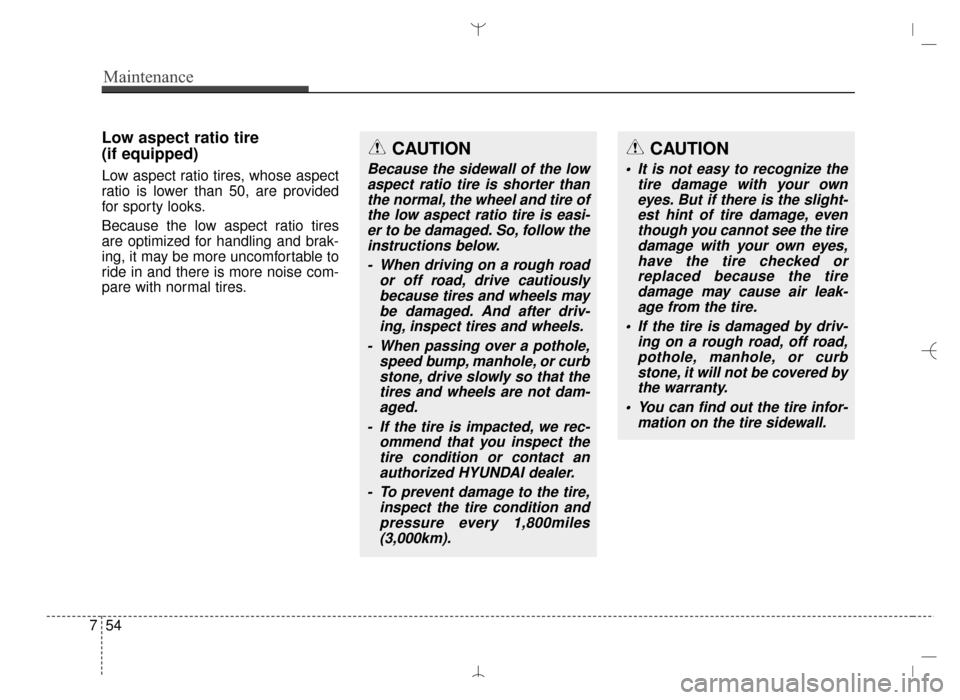
Maintenance
54
7
Low aspect ratio tire
(if equipped)
Low aspect ratio tires, whose aspect
ratio is lower than 50, are provided
for sporty looks.
Because the low aspect ratio tires
are optimized for handling and brak-
ing, it may be more uncomfortable to
ride in and there is more noise com-
pare with normal tires.
CAUTION
Because the sidewall of the low
aspect ratio tire is shorter thanthe normal, the wheel and tire ofthe low aspect ratio tire is easi-er to be damaged. So, follow theinstructions below.
- When driving on a rough road or off road, drive cautiouslybecause tires and wheels maybe damaged. And after driv-ing, inspect tires and wheels.
- When passing over a pothole, speed bump, manhole, or curbstone, drive slowly so that thetires and wheels are not dam-aged.
- If the tire is impacted, we rec- ommend that you inspect thetire condition or contact anauthorized HYUNDAI dealer.
- To prevent damage to the tire, inspect the tire condition andpressure every 1,800miles(3,000km).
CAUTION
It is not easy to recognize the tire damage with your owneyes. But if there is the slight-est hint of tire damage, eventhough you cannot see the tiredamage with your own eyes,have the tire checked orreplaced because the tiredamage may cause air leak-age from the tire.
If the tire is damaged by driv- ing on a rough road, off road,pothole, manhole, or curbstone, it will not be covered bythe warranty.
You can find out the tire infor- mation on the tire sidewall.
AN HMA 7.QXP 3/5/2015 3:25 PM Page 54
Page 703 of 763
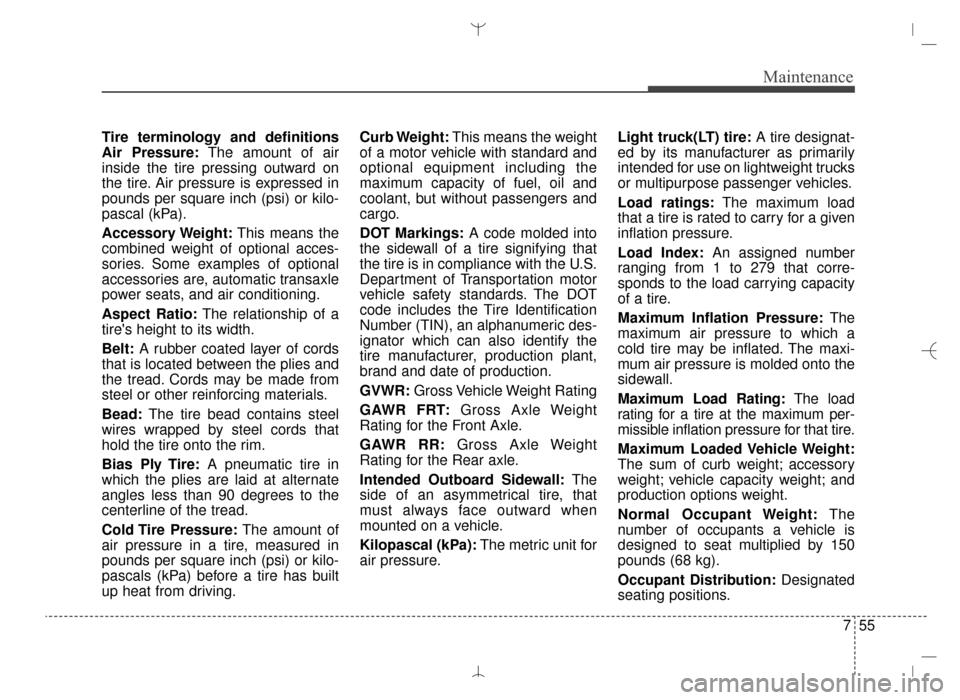
755
Maintenance
Tire terminology and definitions
Air Pressure:The amount of air
inside the tire pressing outward on
the tire. Air pressure is expressed in
pounds per square inch (psi) or kilo-
pascal (kPa).
Accessory Weight: This means the
combined weight of optional acces-
sories. Some examples of optional
accessories are, automatic transaxle
power seats, and air conditioning.
Aspect Ratio: The relationship of a
tire's height to its width.
Belt: A rubber coated layer of cords
that is located between the plies and
the tread. Cords may be made from
steel or other reinforcing materials.
Bead: The tire bead contains steel
wires wrapped by steel cords that
hold the tire onto the rim.
Bias Ply Tire: A pneumatic tire in
which the plies are laid at alternate
angles less than 90 degrees to the
centerline of the tread.
Cold Tire Pressure: The amount of
air pressure in a tire, measured in
pounds per square inch (psi) or kilo-
pascals (kPa) before a tire has built
up heat from driving. Curb Weight:
This means the weight
of a motor vehicle with standard and
optional equipment including the
maximum capacity of fuel, oil and
coolant, but without passengers and
cargo.
DOT Markings: A code molded into
the sidewall of a tire signifying that
the tire is in compliance with the U.S.
Department of Transportation motor
vehicle safety standards. The DOT
code includes the Tire Identification
Number (TIN), an alphanumeric des-
ignator which can also identify the
tire manufacturer, production plant,
brand and date of production.
GVWR: Gross Vehicle Weight Rating
GAWR FRT: Gross Axle Weight
Rating for the Front Axle.
GAWR RR: Gross Axle Weight
Rating for the Rear axle.
Intended Outboard Sidewall: The
side of an asymmetrical tire, that
must always face outward when
mounted on a vehicle.
Kilopascal (kPa): The metric unit for
air pressure. Light truck(LT) tire:
A tire designat-
ed by its manufacturer as primarily
intended for use on lightweight trucks
or multipurpose passenger vehicles.
Load ratings: The maximum load
that a tire is rated to carry for a given
inflation pressure.
Load Index: An assigned number
ranging from 1 to 279 that corre-
sponds to the load carrying capacity
of a tire.
Maximum Inflation Pressure: The
maximum air pressure to which a
cold tire may be inflated. The maxi-
mum air pressure is molded onto the
sidewall.
Maximum Load Rating: The load
rating for a tire at the maximum per-
missible inflation pressure for that tire.
Maximum Loaded Vehicle Weight:
The sum of curb weight; accessory
weight; vehicle capacity weight; and
production options weight.
Normal Occupant Weight: The
number of occupants a vehicle is
designed to seat multiplied by 150
pounds (68 kg).
Occupant Distribution: Designated
seating positions.
AN HMA 7.QXP 3/5/2015 3:25 PM Page 55
Page 705 of 763
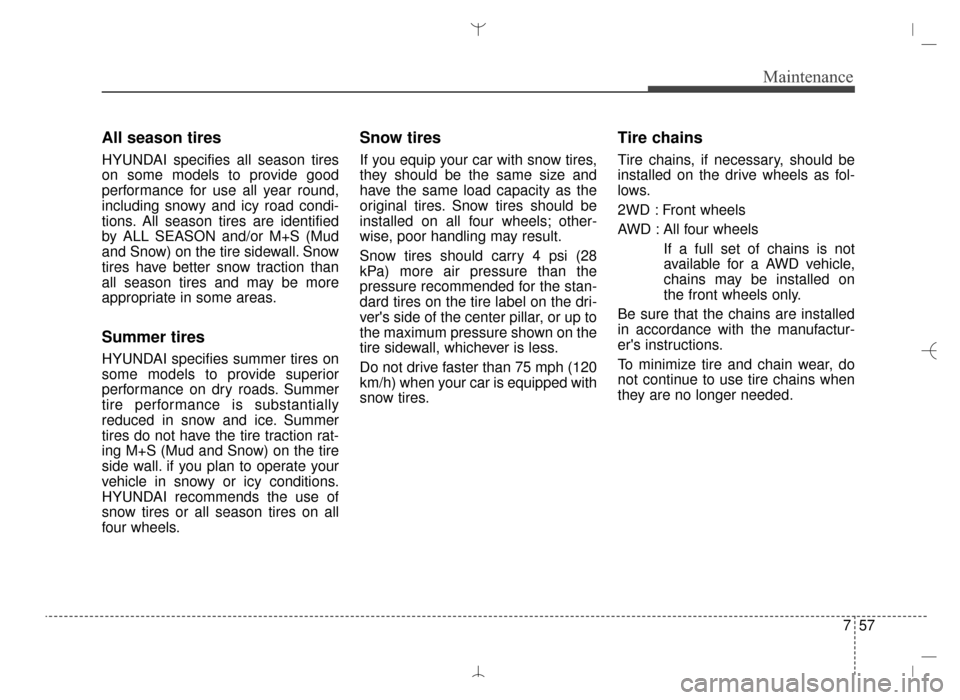
757
Maintenance
All season tires
HYUNDAI specifies all season tires
on some models to provide good
performance for use all year round,
including snowy and icy road condi-
tions. All season tires are identified
by ALL SEASON and/or M+S (Mud
and Snow) on the tire sidewall. Snow
tires have better snow traction than
all season tires and may be more
appropriate in some areas.
Summer tires
HYUNDAI specifies summer tires on
some models to provide superior
performance on dry roads. Summer
tire performance is substantially
reduced in snow and ice. Summer
tires do not have the tire traction rat-
ing M+S (Mud and Snow) on the tire
side wall. if you plan to operate your
vehicle in snowy or icy conditions.
HYUNDAI recommends the use of
snow tires or all season tires on all
four wheels.
Snow tires
If you equip your car with snow tires,
they should be the same size and
have the same load capacity as the
original tires. Snow tires should be
installed on all four wheels; other-
wise, poor handling may result.
Snow tires should carry 4 psi (28
kPa) more air pressure than the
pressure recommended for the stan-
dard tires on the tire label on the dri-
ver's side of the center pillar, or up to
the maximum pressure shown on the
tire sidewall, whichever is less.
Do not drive faster than 75 mph (120
km/h) when your car is equipped with
snow tires.
Tire chains
Tire chains, if necessary, should be
installed on the drive wheels as fol-
lows.
2WD : Front wheels
AWD : All four wheelsIf a full set of chains is not
available for a AWD vehicle,
chains may be installed on
the front wheels only.
Be sure that the chains are installed
in accordance with the manufactur-
er's instructions.
To minimize tire and chain wear, do
not continue to use tire chains when
they are no longer needed.
AN HMA 7.QXP 3/5/2015 3:25 PM Page 57
Page 733 of 763
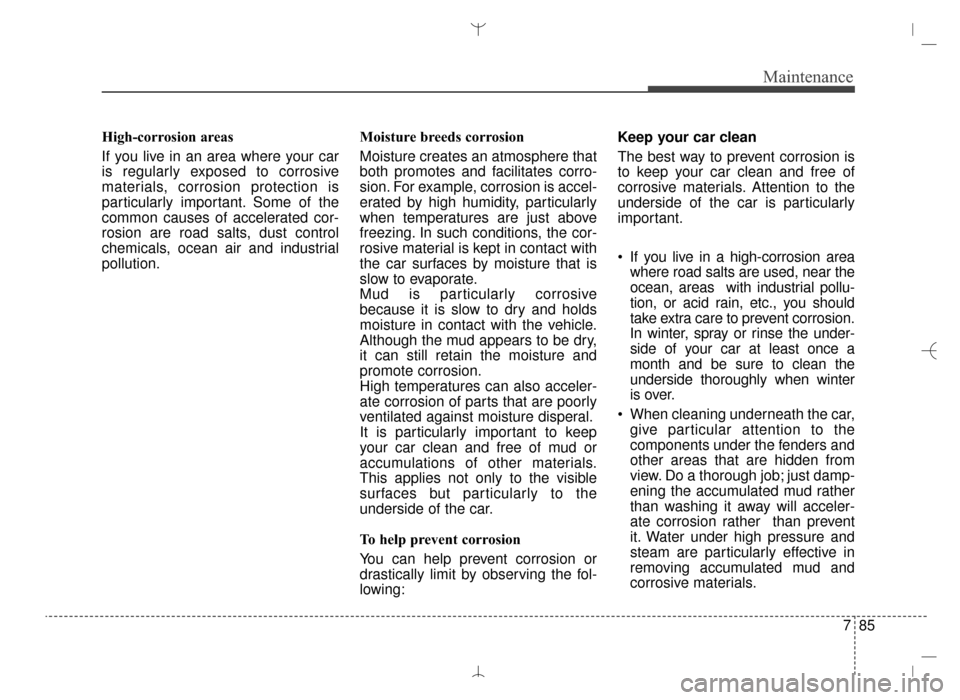
785
Maintenance
High-corrosion areas
If you live in an area where your car
is regularly exposed to corrosive
materials, corrosion protection is
particularly important. Some of the
common causes of accelerated cor-
rosion are road salts, dust control
chemicals, ocean air and industrial
pollution.Moisture breeds corrosion
Moisture creates an atmosphere that
both promotes and facilitates corro-
sion. For example, corrosion is accel-
erated by high humidity, particularly
when temperatures are just above
freezing. In such conditions, the cor-
rosive material is kept in contact with
the car surfaces by moisture that is
slow to evaporate.
Mud is particularly corrosive
because it is slow to dry and holds
moisture in contact with the vehicle.
Although the mud appears to be dry,
it can still retain the moisture and
promote corrosion.
High temperatures can also acceler-
ate corrosion of parts that are poorly
ventilated against moisture disperal.
It is particularly important to keep
your car clean and free of mud or
accumulations of other materials.
This applies not only to the visible
surfaces but particularly to the
underside of the car.
To help prevent corrosion
You can help prevent corrosion or
drastically limit by observing the fol-
lowing:Keep your car clean
The best way to prevent corrosion is
to keep your car clean and free of
corrosive materials. Attention to the
underside of the car is particularly
important.
If you live in a high-corrosion area
where road salts are used, near the
ocean, areas with industrial pollu-
tion, or acid rain, etc., you should
take extra care to prevent corrosion.
In winter, spray or rinse the under-
side of your car at least once a
month and be sure to clean the
underside thoroughly when winter
is over.
When cleaning underneath the car, give particular attention to the
components under the fenders and
other areas that are hidden from
view. Do a thorough job; just damp-
ening the accumulated mud rather
than washing it away will acceler-
ate corrosion rather than prevent
it. Water under high pressure and
steam are particularly effective in
removing accumulated mud and
corrosive materials.
AN HMA 7.QXP 3/5/2015 3:25 PM Page 85
Page 738 of 763
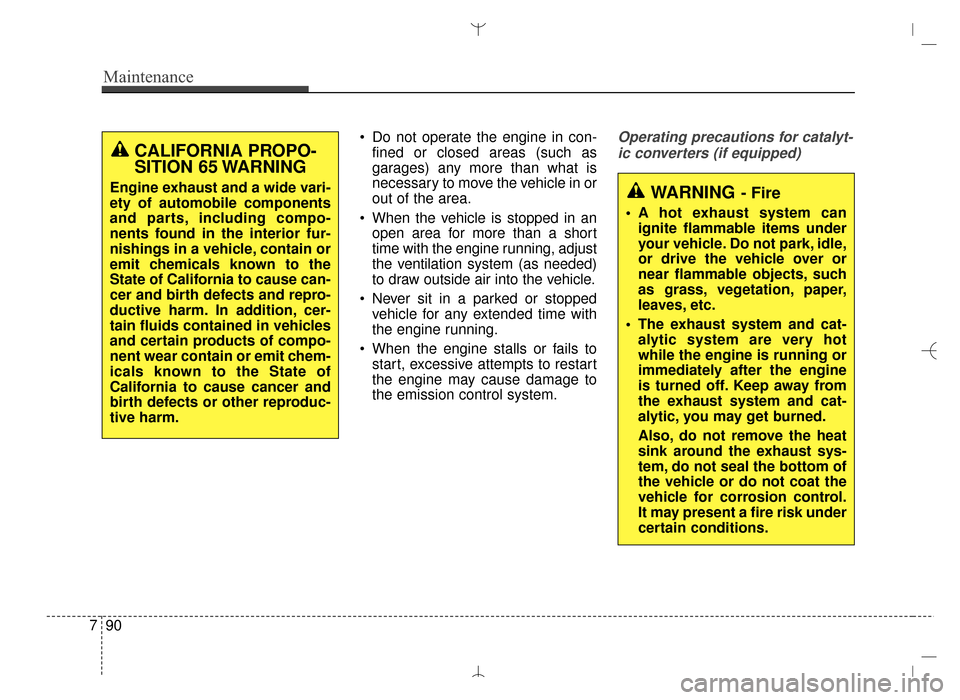
Maintenance
90
7
Do not operate the engine in con-
fined or closed areas (such as
garages) any more than what is
necessary to move the vehicle in or
out of the area.
When the vehicle is stopped in an open area for more than a short
time with the engine running, adjust
the ventilation system (as needed)
to draw outside air into the vehicle.
Never sit in a parked or stopped vehicle for any extended time with
the engine running.
When the engine stalls or fails to start, excessive attempts to restart
the engine may cause damage to
the emission control system.Operating precautions for catalyt-
ic converters (if equipped)
CALIFORNIA PROPO-
SITION 65 WARNING
Engine exhaust and a wide vari-
ety of automobile components
and parts, including compo-
nents found in the interior fur-
nishings in a vehicle, contain or
emit chemicals known to the
State of California to cause can-
cer and birth defects and repro-
ductive harm. In addition, cer-
tain fluids contained in vehicles
and certain products of compo-
nent wear contain or emit chem-
icals known to the State of
California to cause cancer and
birth defects or other reproduc-
tive harm.WARNING- Fire
A hot exhaust system can ignite flammable items under
your vehicle. Do not park, idle,
or drive the vehicle over or
near flammable objects, such
as grass, vegetation, paper,
leaves, etc.
The exhaust system and cat- alytic system are very hot
while the engine is running or
immediately after the engine
is turned off. Keep away from
the exhaust system and cat-
alytic, you may get burned.
Also, do not remove the heat
sink around the exhaust sys-
tem, do not seal the bottom of
the vehicle or do not coat the
vehicle for corrosion control.
It may present a fire risk under
certain conditions.
AN HMA 7.QXP 3/5/2015 3:25 PM Page 90
Page 741 of 763
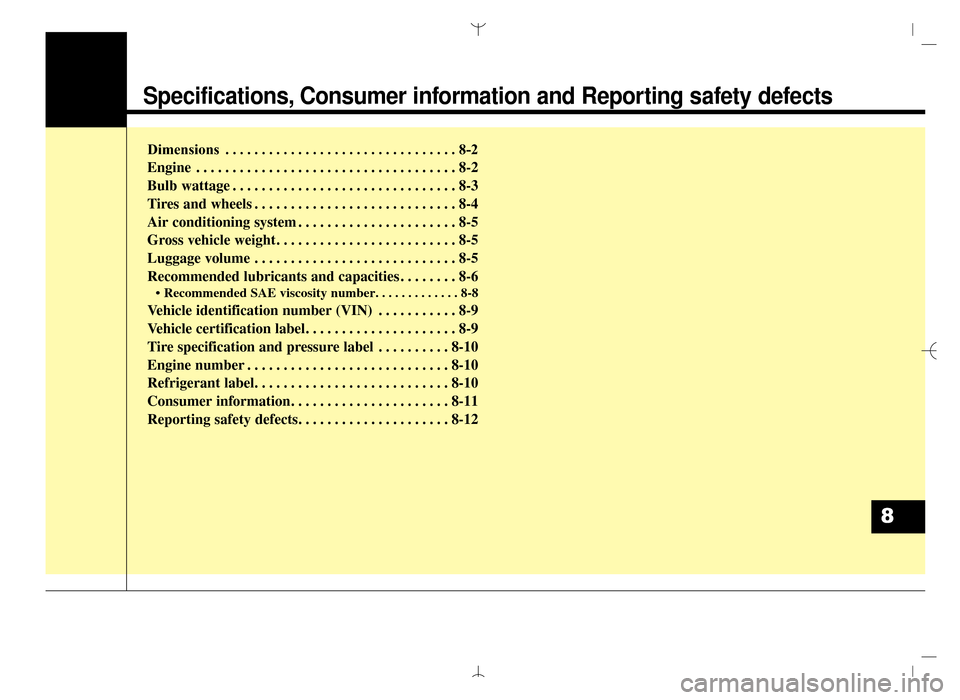
Specifications, Consumer information and Reporting safety defects
Dimensions . . . . . . . . . . . . . . . . . . . . . . . . . . . . . . . . 8-2
Engine . . . . . . . . . . . . . . . . . . . . . . . . . . . . . . . . . . . . \
8-2
Bulb wattage . . . . . . . . . . . . . . . . . . . . . . . . . . . . . . . 8-3
Tires and wheels . . . . . . . . . . . . . . . . . . . . . . . . . . . . 8-4
Air conditioning system . . . . . . . . . . . . . . . . . . . . . . 8-5
Gross vehicle weight. . . . . . . . . . . . . . . . . . . . . . . . . 8-5
Luggage volume . . . . . . . . . . . . . . . . . . . . . . . . . . . . 8-5
Recommended lubricants and capacities . . . . . . . . 8-6
• Recommended SAE viscosity number. . . . . . . . . . . . . 8-8
Vehicle identification number (VIN) . . . . . . . . . . . 8-9
Vehicle certification label. . . . . . . . . . . . . . . . . . . . . 8-9
Tire specification and pressure label . . . . . . . . . . 8-10
Engine number . . . . . . . . . . . . . . . . . . . . . . . . . . . . 8-10
Refrigerant label. . . . . . . . . . . . . . . . . . . . . . . . . . . 8-10
Consumer information. . . . . . . . . . . . . . . . . . . . . . 8-11
Reporting safety defects. . . . . . . . . . . . . . . . . . . . . 8-12
8
AN HMA 8.QXP 2015-02-03 ¿ ¨˜ 1:55 Page 1
Page 745 of 763
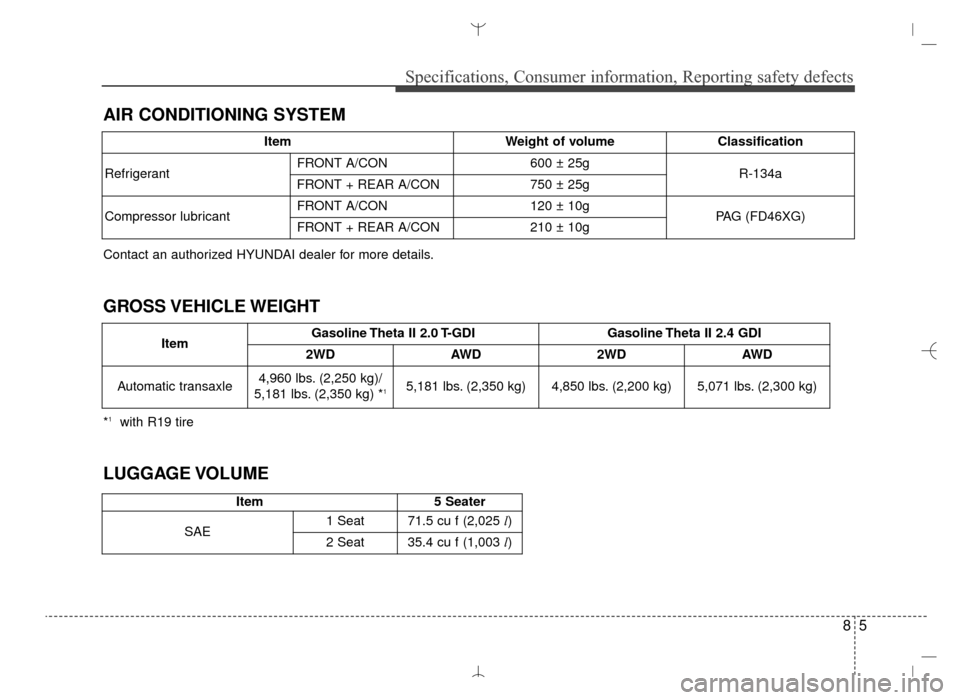
85
Specifications, Consumer information, Reporting safety defects
GROSS VEHICLE WEIGHT
LUGGAGE VOLUME
Item5 Seater
SAE 1 Seat
71.5 cu f (2,025
l)
2 Seat 35.4 cu f (1,003
l)
Item Gasoline Theta II 2.0 T-GDI Gasoline Theta II 2.4 GDI
2WD AWD 2WD AWD
Automatic transaxle 4,960 lbs. (2,250 kg)/
5,181 lbs. (2,350 kg) *
15,181 lbs. (2,350 kg) 4,850 lbs. (2,200 kg) 5,071 lbs. (2,300 kg)
*1with R19 tire
AIR CONDITIONING SYSTEM
ItemWeight of volume Classification
Refrigerant FRONT A/CON
600 ± 25g
R-134a
FRONT + REAR A/CON
750 ± 25g
Compressor lubricant FRONT A/CON
120 ± 10g
PAG (FD46XG)
FRONT + REAR A/CON
210 ± 10g
Contact an authorized HYUNDAI dealer for more details.
AN HMA 8.QXP 2015-02-03 ¿ ¨˜ 1:55 Page 5
Page 754 of 763
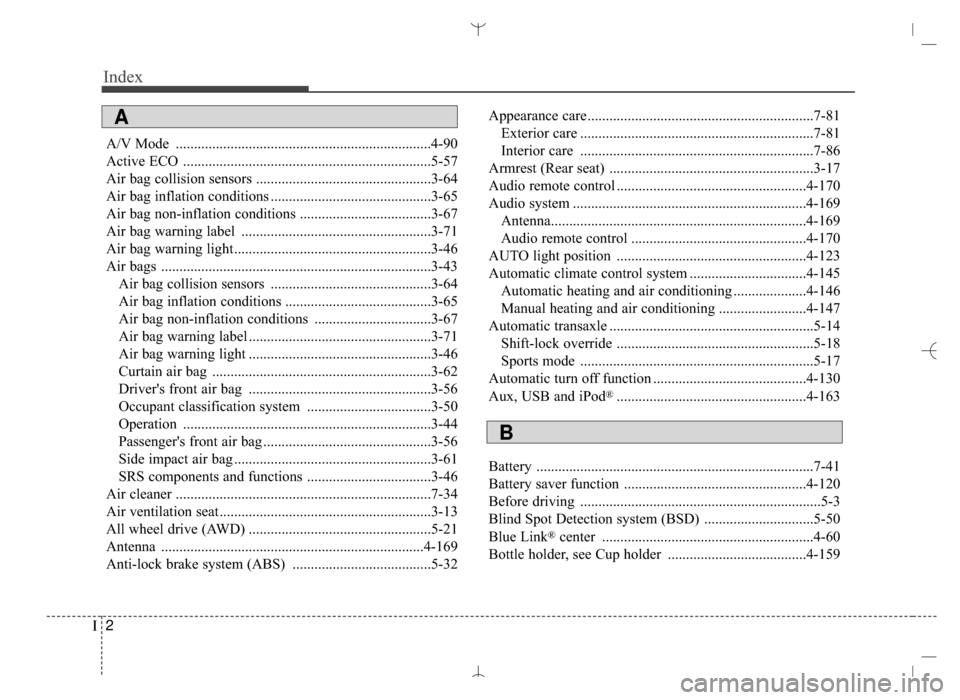
Index
2I
A/V Mode ......................................................................4-\
90
Active ECO ....................................................................5-57\
Air bag collision sensors ................................................3-64
Air bag inflation conditions ............................................3-65
Air bag non-inflation conditions ....................................3-67
Air bag warning label ....................................................3-71
Air bag warning light......................................................3-46
Air bags ........................................................................\
..3-43Air bag collision sensors ............................................3-64
Air bag inflation conditions ........................................3-65
Air bag non-inflation conditions ................................3-67
Air bag warning label ..................................................3-71
Air bag warning light ..................................................3-46
Curtain air bag ............................................................3-62
Driver's front air bag ..................................................3-56
Occupant classification system ..................................3-50
Operation ....................................................................3-44\
Passenger's front air bag ..............................................3-56
Side impact air bag ......................................................3-61
SRS components and functions ..................................3-46
Air cleaner ......................................................................7-\
34
Air ventilation seat..........................................................3-13
All wheel drive (AWD) ..................................................5-21
Antenna ........................................................................\
4-169
Anti-lock brake system (ABS) ......................................5-32 Appearance care..............................................................7-81
Exterior care ................................................................7-81
Interior care ................................................................7-86
Armrest (Rear seat) ........................................................3-17
Audio remote control ....................................................4-170
Audio system ................................................................4-169 Antenna......................................................................4-\
169
Audio remote control ................................................4-170
AUTO light position ....................................................4-123
Automatic climate control system ................................4-145 Automatic heating and air conditioning ....................4-146
Manual heating and air conditioning ........................4-147
Automatic transaxle ........................................................5-14 Shift-lock override ......................................................5-18
Sports mode ................................................................5-17
Automatic turn off function ..........................................4-130
Aux, USB and iPod
®....................................................4-163
Battery ........................................................................\
....7-41
Battery saver function ..................................................4-120
Before driving ..................................................................5-3
Blind Spot Detection system (BSD) ..............................5-50
Blue Link
®center ..........................................................4-60
Bottle holder, see Cup holder ......................................4-159
A
B
AN HMA INDEX.QXP 3/3/2015 11:36 AM Page 2